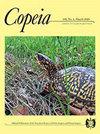Movement and Habitat Selection of Eastern Milksnakes (Lampropeltis triangulum) at Intact and Fragmented Sites
IF 2.6
Q2 Agricultural and Biological Sciences
引用次数: 3
Abstract
Habitat loss and fragmentation are among the greatest threats to wildlife and biodiversity. Reptiles are particularly susceptible to these threats due to high site fidelity, large home ranges, and slow movement rates. To understand behavioral responses of Eastern Milksnakes (Lampropeltis triangulum) to fragmentation, we compared home range size and movement rates between a fragmented habitat and an intact habitat. Additionally, we quantified road avoidance and habitat selection in the fragmented habitat. In 2015 and 2016, we collected 453 locations from 17 individuals from Rouge National Urban Park (RNUP), the fragmented study area, using radio-telemetry. We compared our results to a previous study with 1,001 locations from 30 individuals at Queen's University Biological Station (QUBS), our intact study area, collected from 2003 to 2004. We found that home ranges were smaller, but daily movement rate (DMD) and distance-per-move (DPM) were greater in the fragmented study area. We also observed that road crossings by snakes occurred less than expected, suggesting active avoidance of roads. Milksnakes in the fragmented habitat selected locations with a greater number of cover objects within open patches surrounded by high density vegetation, which is consistent with previous findings from the intact habitat. Our findings suggest that Eastern Milksnakes benefit from heterogeneous microhabitats and an abundance of available anthropogenic or natural cover.东部乳蛇(Lampropeltis triangulum)在完整和破碎地的迁移和生境选择
栖息地丧失和破碎化是野生动物和生物多样性面临的最大威胁之一。爬行动物特别容易受到这些威胁,因为它们的位置保真度高,活动范围大,移动速度慢。为了了解东部乳蛇(Lampropeltis triangulum)对破碎化的行为反应,我们比较了破碎化栖息地和完整栖息地的范围大小和移动速度。此外,我们还量化了破碎化生境中的道路回避和生境选择。在2015年和2016年,我们使用无线电遥测技术,从Rouge国家城市公园(RNUP)的碎片化研究区收集了17个个体的453个位置。我们将我们的结果与之前的研究结果进行了比较,该研究从2003年到2004年在女王大学生物站(QUBS)的30个个体中收集了1001个地点,我们的完整研究区域。我们发现,在破碎的研究区域,家园范围较小,但每日移动率(DMD)和每次移动距离(DPM)较大。我们还观察到,蛇穿过道路的情况比预期的要少,这表明蛇主动避开道路。碎片化生境中的乳蛇选择了高密度植被包围的开阔斑块中覆盖物较多的位置,这与先前在完整生境中的发现一致。我们的研究结果表明,东部乳蛇受益于异质性微栖息地和丰富的可用人为或自然覆盖。
本文章由计算机程序翻译,如有差异,请以英文原文为准。
求助全文
约1分钟内获得全文
求助全文
来源期刊

Copeia
生物-动物学
CiteScore
2.10
自引率
0.00%
发文量
0
审稿时长
6-12 weeks
期刊介绍:
Founded in 1913, Copeia is a highly respected international journal dedicated to the publication of high quality, original research papers on the behavior, conservation, ecology, genetics, morphology, evolution, physiology, systematics and taxonomy of extant and extinct fishes, amphibians, and reptiles. Copeia is published electronically and is available through BioOne. Articles are published online first, and print issues appear four times per year. In addition to research articles, Copeia publishes invited review papers, book reviews, and compiles virtual issues on topics of interest drawn from papers previously published in the journal.
 求助内容:
求助内容: 应助结果提醒方式:
应助结果提醒方式:


